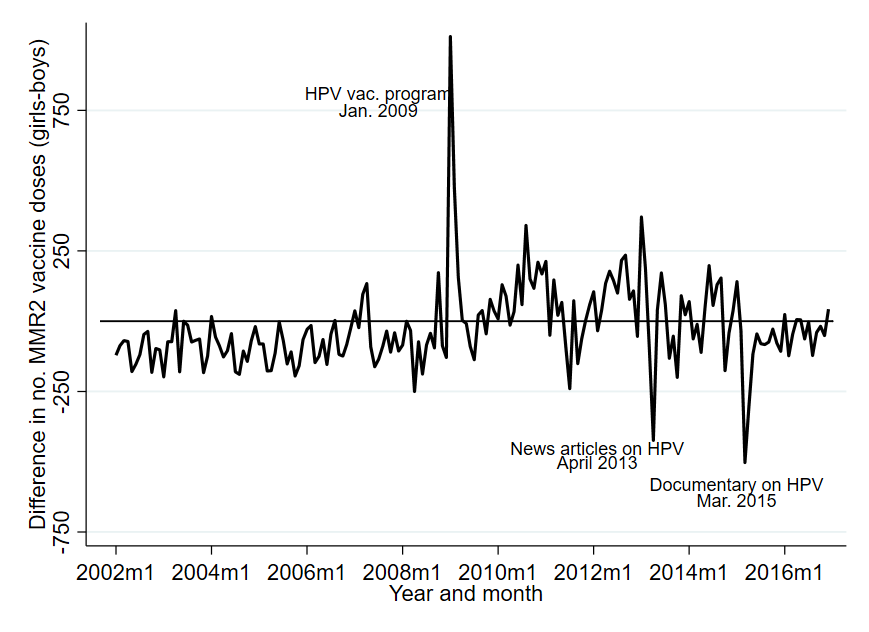The contagious nature of a vaccine scare
HPV vaccine was introduced for girls in Denmark in 2009. Being a cure for cervical cancer parents rushed to their general physician to have their daughters vaccined. And once they were at their doctor’s they had the opportunity to boost their daugthers' MMR vaccine – the one that keeps measles, mumps and rubella away.
Thus, the introduction of HPV vaccine was popular and it had positive spill-over effects on MMR vaccine uptake and coverage on Danish adolesents.
Then in 2013 Danish newspapers started covering possible serious (but unsubstantiated) side effects to the vaccine. Stories were told about girls suffering from cramps, dizzyness, frequent headaches, fainting, and tiredness and the physical symptoms were interpreted as connected to the HPV vaccine. Danish television followed up in 2015 broadcasting a documentary on what was framed as possible severe side effects of the vaccine.
The media coverage cost a serious decline in HPV vaccine uptake. While around 95% of the adolesents wanted the vaccine during the first years, only around 30% had it after the news scare had made its impact.
Contagious media attention
The influence the media scare had on HPV vaccine uptake is established knowledge. The news is, that the media coverage did not only affect the HPV vaccine uptake – also the MMR vaccine uptake was affected.
Childhood vaccination programms are among the most cost effective public health interventions. Negative media attention thus have serious impact on societal health – and with the new results from Mette Gørtz and Mette Ejrnæs the impact has shown to be bigger than first thought and registered. The research results are published in the medical peer reviewed journal Vaccine.
Mette Gørtz and Mette Ejrnæs document spillover effects in vaccination rates across concomitant vaccines. The introduction of HPV vaccine in Denmark supported higher MMR2 vaccination rates for girls. However, following negative media attention on HPV vaccination, MMR2 coverage fell considerably for girls.

The well educated are more sensitive to media scare
Previous studies have shown conflicting results for the significance of parental education and income in vaccination. In the UK, for instance parents with more education were more prone to drop the MMR vaccine after a publication of serious negative side effects of MMR vaccine in 1998. Similarly, a US study found that it was the high-educated who reduced vaccination rates of their children the most. A Danish study found that HPV uptake was lower for girls born to parents with lower education.
Mette Gørtz and Mette Ejrnæs find that highly-educated mothers were apparently more sensitive to negative information about HPV vaccine leading to a higher drop in general vaccination rates for their daughters:
“Parental education shaped the effects we saw on MMR2 and HPV1 coverage. We documented an inverted U-shape in MMR2 vaccine coverage as a function of maternal education. Mothers with the least or the most education had daughters with the lowest MMR2 coverage. The inverted U-shape was also present for HPV1 coverage, for the first six cohorts. Most importantly, the last cohort, 2003, experienced a sharp decline in HPV1 coverage, and the decline was far more pronounced for those with high levels of education, resulting in HPV1 coverage being downwards sloping as a function of parental education for cohort 2003.”
If you do not have access to the full paper you are welcome to contact Mette Gørtz or Mette Ejrnæs to request a pre-print of the paper.
